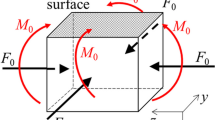Abstract
This paper deals with the analysis of elastic strain and eigenstrain in non-uniformly shaped shot-peened 17-4PH stainless steel samples. Based on residual strain measurements by synchrotron X-ray diffraction, the finite element (FE) models are established for the inverse problem of eigenstrain analysis in slice conical sample. The eigenstrains obtained in the slice are then implemented into the FE model of the solid conical sample. It is found that the dependence of elastic strain distributions on the peening intensity and sample shape/thickness could be elucidated via the understanding of underlying permanent strain, or eigenstrain. The effect of the peening process is therefore best described in terms of the induced eigenstrain. The proposed framework is useful for the predictive modelling of residual stresses in non-uniformly shaped shot-peened materials, in that it allows efficient reconstruction of complete residual stress states. In addition, it provides an excellent basis for developing predictive tools for in service performance and design optimisation.











Similar content being viewed by others
References
Xing YM, Lu J (2004) An experimental study of residual stress induced by ultrasonic shot peening. J Mater Process Tech 152:56–61
Li JK, Mei Y, Duo W, Renzhi W (1991) Mechanical approach to the residual stress field induced by shot peening. Mater Sci Eng 147:167–173
Turnbull A, Pitts JJ, Lord JD (2008) Residual stress relaxation in shot peened high strength low alloy steel. Mater Sci Tech 24(3):327–334
Menig R, Pintschovius L, Schulze V, Vöhringer O (2001) Depth profiles of macro residual stresses in thin shot peened steel plates determined by X-ray and neutron diffraction. Scripta Mater 45:977–983
Zakharchenko I, Gulak Y, Zhong Z, Croft M, Tsakalakos T (2003) Application of synchrotron EDXRD strain profiling in shot peened materials. Adv X Ray Anal 46:338–345
Zhang SY, Venter A, Vorster WJJ, Korsunsky AM (2008) High-energy synchrotron X-ray analysis of residual plastic strains induced in shot-peened steel plates. J Strain Anal 43:229–241
Korsunsky AM (2005) On the modelling of residual stresses due to surface peening using eigenstrain distribution. J Strain Anal 40(8):817–824
Venter AM, la Grange CP, Hofmann F, Jun T-S, Belnoue J, Van Heerden PR, Evans A, Korsunsky AM (2008) Synchrotron investigations of non-uniformly shaped shot-peened samples. In: Proceeding of Zeitschrift für Kristallographie
Korsunsky AM (1997) An analysis of residual stresses and strains in shot-peening. In: Proceeding of the 5th International Conference of Residual Stresses. Linkoping, Sweden.
Wohlfahrt H (1982) Shot peening and residual stresses. In: Proceeding of the Sagamore Army Materials Research Conference, pp 71–92
Timoshenko S (1987) Theory of elasticity. McGraw-Hill, New York
Gere JM, Timoshenko S (1999) Mechanics of materials. Stanley Thornes, Cheltenham
Pyzalla A (2000) Methods and feasibility of residual stress analysis by high-energy synchrotron radiation in transmission geometry using a white beam. J Nondestr Eval 19(1):21–31
Reimers W, Pyzalla A, Broda M, Brusch G, Dantz D, Schmackers T, Liss K-D, Tschentscher T (1999) The use of high-energy synchrotron diffraction for residual stress analyses. J Mater Sci Lett 18:581–583
Mura T (1987) Micromechanics of defects in solids. Martinus Nijhoff, Dordrecht
Eshelby JD (1957) The determination of the elastic field of an ellipsoidal inclusion. Proc Roy Soc Lond 241:376–396
Korsunsky AM, Regino G, Nowell D (2004) Variational determination of eigenstrain sources of residual stress. In: Proceeding of International Conference on Computational and Experimental Engineering and Science. Madeira
Korsunsky AM (2006) Variational eigenstrain analysis of synchrotron diffraction measurements of residual elastic strain in a bent titanium alloy bar. J Mech Mater Struct 1:101–119
Korsunsky AM (2009) Eigenstrain analysis of residual strains and stresses. J Strain Anal 44:29–43
Korsunsky AM (2006) Residual elastic strain due to laser shock peening: modelling by eigenstrain distribution. J Strain Anal 41(3):195–204
Korsunsky AM, Regino GM, Nowell D (2007) Variational eigenstrain analysis of residual stresses in a welded plate. Int J Solids Struct 44:4574–4591
Jun T-S (2009) Development of the Eigenstrain Reconstruction Method for the interpretation of diffraction stress measurements in engineering components. DPhil Thesis, University of Oxford
Author information
Authors and Affiliations
Corresponding author
Rights and permissions
About this article
Cite this article
Jun, TS., Venter, A. & Korsunsky, A. Inverse Eigenstrain Analysis of the Effect of Non-uniform Sample Shape on the Residual Stress Due to Shot Peening. Exp Mech 51, 165–174 (2011). https://doi.org/10.1007/s11340-010-9346-2
Received:
Accepted:
Published:
Issue Date:
DOI: https://doi.org/10.1007/s11340-010-9346-2




